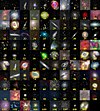NGC 5694
| Kugelsternhaufen NGC 5694 | |
|---|---|
 | |
| Aufnahme des Hubble-Weltraumteleskops | |
| AladinLite | |
| Sternbild | Wasserschlange |
| Position Äquinoktium: J2000.0, Epoche: J2000.0 | |
| Rektaszension | 14h 39m 36,5s [1] |
| Deklination | -26° 32′ 18″ [1] |
| Erscheinungsbild | |
| Konzentrationsklasse | VII [2] |
| Helligkeit (visuell) | 10,20 mag [2] |
| Winkelausdehnung | 4.3' [2] |
| Physikalische Daten | |
| Entfernung | 113,2 kLj |
| Geschichte | |
| Entdeckung | William Herschel |
| Entdeckungsdatum | 22. Mai 1784 |
| Katalogbezeichnungen | |
| NGC 5694 • C 1436-263 • GCl 29 • ESO 512-SC010 • GC 3954 • H II 196, h 3576 | |
NGC 5694 ist ein Kugelsternhaufen im Sternbild Wasserschlange. Möglicherweise entfernt sich NGC 5694 aus unserem Milchstraßensystem. NGC 5694 hat eine Helligkeit von 10,2 mag und einen Winkeldurchmesser von 4,3 Bogenminuten. NGC 5694 ist 113200 Lichtjahre entfernt und wurde am 22. Mai 1784 von William Herschel entdeckt.[3]
Weblinks
- NGC 5694 -Escaping Globular from the Galaxy? Archiviert vom Original am 21. November 2008; abgerufen am 18. Dezember 2013.
- Globular Cluster NGC 5694, class VII
Literatur
- W. Harris, J. Hesser, NGC 5694: A Globular Cluster Escaping from the Galaxy?, Publications of the Astronomical Society of the Pacific 88, 1976, S. 377–379
- R. Burnham Jr., Burham's Celestial Handbook, Dover Publications, New York, 1978, S. 1031
- P. Murdin, D. Allen, D. Malin, Catalogue of the Universe, 1979, Book Club Associates, London, Cambridge University Press, ISBN 0-517-536161
- M. Hazen, A Search for Variable Stars in the Globular Clusters NGC 5694 and NGC 6558, Astronomical Journal, 111, No. 3, 1996, S. 1184
Einzelnachweise
Auf dieser Seite verwendete Medien
Autor/Urheber: Roberto Mura, Lizenz: CC BY-SA 3.0
Caldwell Catalogue objects.
Autor/Urheber: Judy Schmidt, Lizenz: CC BY 2.0
Found some data for NGC 5694 today. This is the core of the globular cluster. I haven't bothered with globular clusters before but this one seems to have rarely been processed. The problem I have with globular clusters is that they all look the same to me. I know they cool things and we can learn a lot from them but at best they look like gems without the animated sparkle and at worst I once seriously thought one was a pile of salt on black velvet. Apparently they are very rewarding to view directly through a telescope. I wouldn't know. :(
I used the f170w data in the blue channel to represent ultraviolet. Hopefully I'm not mistaken that it's UV. All the information I could find on it indicated it was such. So anyway, some of the stars are very blue and that's why.
Red: hst_11975_40_wfpc2_f555w_pc_sci + hst_05902_01_wfpc2_f555w_pc_sci Green: hst_08095_11_wfpc2_f439w_pc_sci + hst_05902_01_wfpc2_f439w_pc_sci Blue: hst_05902_01_wfpc2_f336w_pc_sci + hst_11975_40_wfpc2_f300w_pc_sci + hst_11975_40_wfpc2_f170w_pc_sci
North NOT up, it is 33° counter-clockwise from up.

